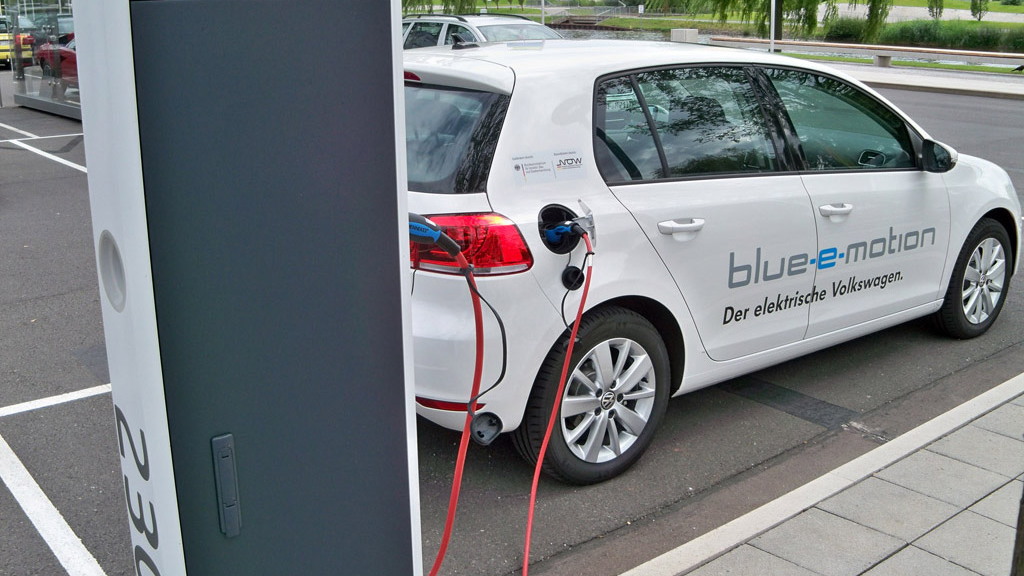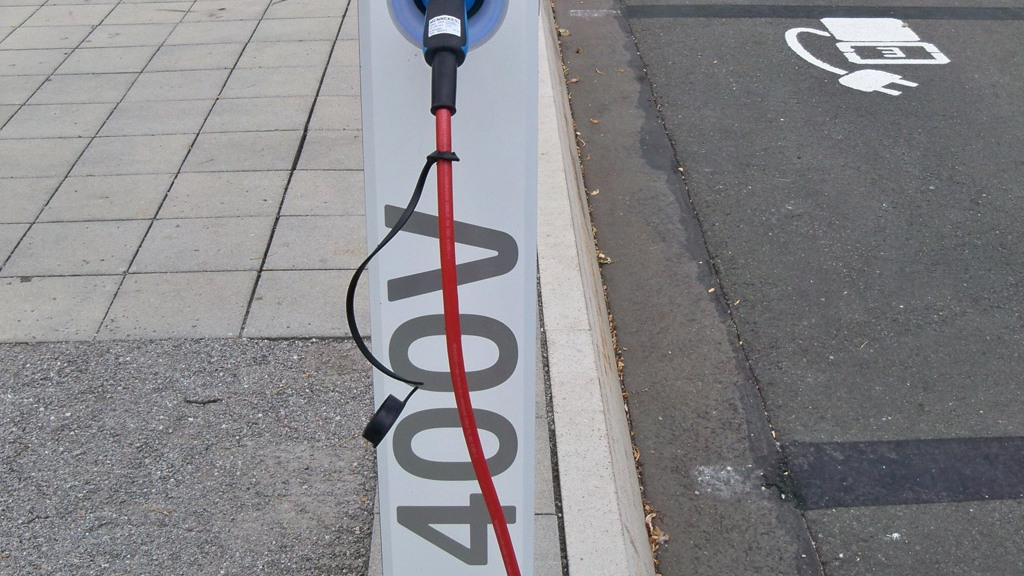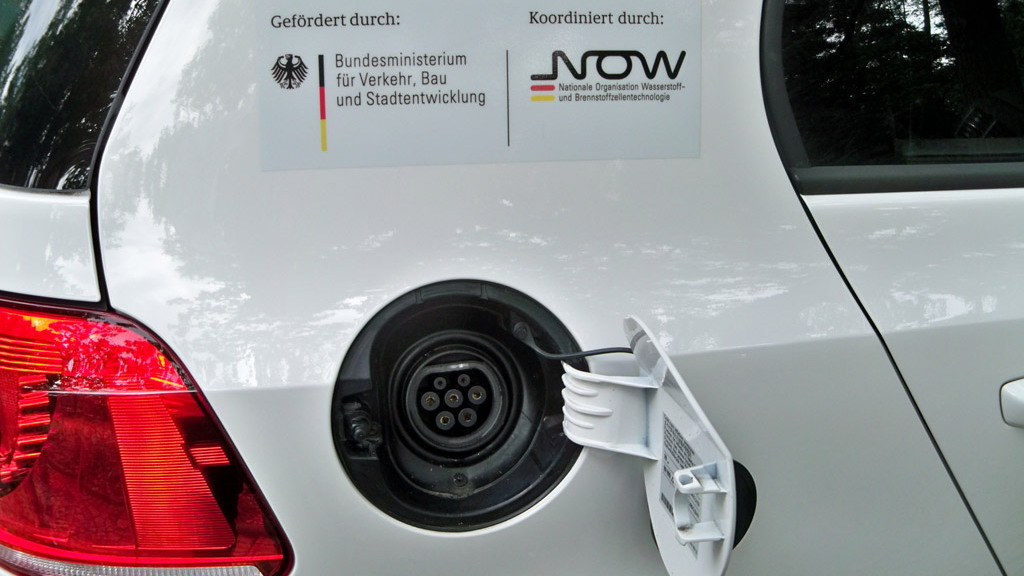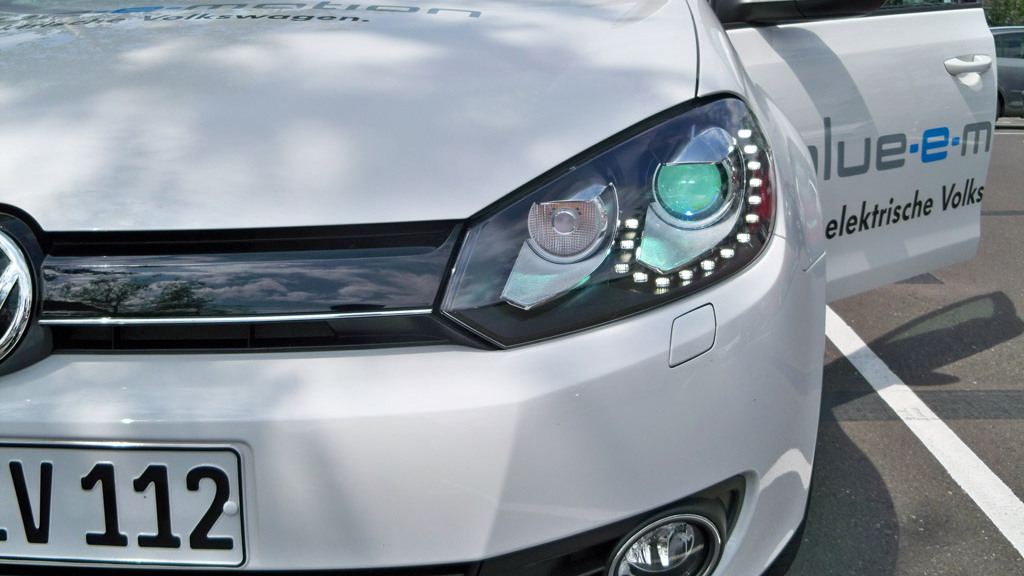Volkswagen is intent on becoming the world's leading automaker by 2018 and that means being top dog in every segment, including hybrid and electric cars. Previously, the German auto giant announced plans to start building its own electric powertrains and even opened a battery research lab at Silicon Valley in Palo Alto, California.
Since then, we've been treated to the unveilings of a host of hybrid and electric car prototypes, the most famous of which was the E-Up concept car, which is destined to be Volkswagen's first mass-produced electric car and should be rolling off the factory floor in 2013. Unfortunately, the chances of this model being sold in the U.S. are very slim.
There remains, however, hope on the horizon for electric car fans here in the U.S. that also appreciate German engineering. Volkswagen's second electric car, the Golf blue-e-motion, will likely be offered for local sale, and the first prototypes, like the one you see here, should be hitting our shores by February of next year.
Volkswagen will be shipping over a small fleet of about 20 Golf blue-e-motion prototypes for trial use by fleets and government agencies over the course of next year. No locations have been confirmed as yet but expect the usual early adopter states--California and New York--to be included. Trials in Europe have already commenced.
If the trials prove successful, production of the electric Golf will start in 2014. Note, by then, Volkswagen will have already started building its MkVII Golf so the design of the cars will be very different to the prototype you see here, which is based on the current MkVI Golf.
The technology, too, especially in regards to the batteries and charging systems, should also be significantly advanced by the time production starts. Some of the things that are likely to change include the size, weight and power density of the batteries, as well as the charge time and range.
Technology
Right now the prototype comes with an electric motor driving the front wheels, which is powered by a lithium-ion battery. The electric motor is rated at 85-kW (114-horsepower) and 200-pound-feet of torque. This may seem relatively feeble but as we'll see in the Driving Impressions section, it's more than enough for around town, especially since maximum torque is available right off the line.
As we found out during our First Ride in the Golf blue-e-motion, the lithium-ion battery is rated at 26.5-kWh and is divided up into several sections of the vehicle for ideal weight distribution. There are a total of 30 battery modules consisting of 180 lithium-ion cells, and these are cooled with a combination of water and air cooling systems. They are located in the trunk, below the rear bench and in the center tunnel.
They weigh a total of 695-pounds, which is reasonable considering their size and power but are too big to ignore when it comes to handling and dynamics. The prototype vehicle's total curb weight is 3,406-pounds.
Volkswagen claims a driving range of 90 miles, though this will depend heavily on driving style, outside temperatures and whether or not you use the ancillary features such as the air-conditioner. Note, a small solar panel rated at 12-volts is located on the roof of the Golf blue-e-motion and is used to control temperatures within the cabin so that air-conditioning usage is minimized.
A full charge takes about eight hours using a regular household power outlet or between three and four hours using the 400-volt quick charge systems Volkswagen had at its test center in Wolfsburg, Germany. While even the quick charge system will be too slow for 99 percent of drivers, the automaker is working on a DC charging system that could potentially top up the batteries in 20 to 30 minutes. Ideally, these would be located in an electric car charging station where drivers could pull up and charge their batteries when running low.
While the batteries and electric motor are nothing revolutionary, Volkswagen's variety of driving modes for the car are certainly worth a mention. Like most electric cars, the Golf blue-e-motion has a brake energy recovery system.
When you press the brake pedal, the prototype uses the electric motor as a generator and feeds electric power gained from kinetic energy back into the lithium-ion batteries. On many electric cars, there's a tendency to have 'all or nothing' when it comes to brake regeneration. Let go of the accelerator on some electric cars and it feels as though the brakes are being pressed with maximum force.
On the Golf blue-e-motion, the driver has the ability to adjust the severity of the regenerative mode; from minimal resistance to maximum over four different levels. Move the gearshift lever to "B" and you have maximum regenerative braking force--enough to bring the vehicle to a complete halt. This mode is best for when driving around town.
Leave the gearshift lever in "D" and then you have three different modes to choose from, all of which are selectable via paddle shifters located behind the steering wheel. This mode is best for highway driving and gives you the feeling that the car is being slowed by engine braking when you flick through the different modes, but it's really different rates of regenerative braking force.
Finally, there's one more button that also lets you adjust between different driving modes: "Normal", "Eco", and "Range". This feature controls functions like the electric motor, air-conditioner and speed limiter. The most conservative mode is "Range" which limits output from the motor at 70-kW (94-horsepower) and reduces top speed to 60-mph.
Styling
When it comes to styling, the Golf blue-e-motion is a bit of a letdown as it looks identical to a regular Golf--inside and out. In fact, there's nothing to tell you that this is an electric car apart from the fact that there's no tailpipe. Of course, this is still a prototype so by the time production ramps up in 2014 Volkswagen may have added some unique styling details.
Flip the front "VW" logo and there's a charge point behind. There's also a charge point located behind the original gas tank lid but when production starts, only one of these will remain.
Inside, there's nothing out of the ordinary either except that the tacho has been replaced by a power consumption meter. This basically shows you how much power you are using whenever you press the accelerator, and oddly enough it gets you trying to minimize your usage as much as possible. Also new is a display of the regeneration intensity, which is located between the consumption meter and speedo.
A central display screen provides info about where power is going, like when it's being drawn from the battery or from the brakes. There's also trip info about range and other useful statistics, which can be dialed up with the press of a button.
In the trunk, part of the battery and electronics are hidden under a panel. There's also a charging cable stored here. Despite all the technology, there's still a usable 8.4-cubic-feet of storage space here.
Driving Impressions
Hop in and start the car and all you hear is silence. The Golf blue-e-motion is one of the quietest electric cars we've tested. Once you start rolling, however, a noise generator located under the hood mimics the sound of an internal combustion engine so that pedestrians know you're lurking. This sound will emanate until you're traveling above 30-mph at which point tire and wind noise will be loud enough to alert anyone in your path of your impending arrival. Around this point you can also start to hear the electric motor whine.
Acceleration from 0-30 mph is brisk in the Golf blue-e-motion and is more than adequate for an urban commuter vehicle. Getting it up to highway speeds is a bit of a task, with the 0-62 mph run taking a leisurely 11.8 seconds. This thing is really designed for city use where speeds tend to remain below 40-mph.
The feel in the prototype is very similar to an ordinary gasoline powered Golf although the weight of the batteries is impossible to ignore. It's like you're always driving with a couple of linebackers in the back seat. This is especially apparent when you break hard or when you enter a corner with speed.
What's really fun in the Golf blue-e-motion is the different battery regeneration settings. Leave it in "B", the strongest setting, and it's possible to control the vehicle with the accelerator pedal only. Let go as you approach a red light and the vehicle can come to a complete stop by itself. The rear brake lights even light up in this setting whenever you lift your foot of the accelerator.
When hitting the highway, move the gearshift lever to "D" and the vehicle will 'sail' smoothly with hardly any energy usage. If you need to slow down slightly, just flick the paddle shifter and the regenerative brakes will intensify though never to the level of when the gearshift lever is in "B".
Importantly, your driving range will dramatically depending on how much regenerated energy is being drawn from the brakes. Volkswagen's claim of 90 miles is only really possibly under ideal conditions and with 20 miles claimed back from brake energy regeneration. Although our test drive was less than 45 minutes in total, we could imagine even the average driver using a mix of city streets and highways could manage a total range of about 70-80 miles. Volkswagen electric car
Final verdict

Volkswagen has come a long way since the days of its CityStromer electric car based on the MkII Golf from the early 1980s. We'd go so far as to say, if the German auto giant can keep the price to within what's reasonable for a economic hatchback, and improve on the styling, then the 2014 Volkswagen Golf blue-e-motion may just be the electric car to convince the masses. It doesn't hurt that the Golf is already one of the most popular cars on the planet.
Volkswagen provided travel, lodging, and meals to enable High Gear Media to bring you this first-person drive report.




















